
Garden bridges create a charming focal point by spanning water features or garden beds, offering both aesthetic appeal and functional crossing. Stepping stones provide a versatile pathway through greenery, enhancing garden accessibility while blending seamlessly with natural surroundings. Discover which option suits Your outdoor space best by reading the rest of the article.
Table of Comparison
| Feature | Garden Bridge | Stepping Stones |
|---|---|---|
| Purpose | Connects two points over water or uneven terrain | Provides a walking path across grass, soil, or shallow water |
| Design | Elevated structure, often arched or flat with railings | Flat stones or concrete slabs placed level with ground |
| Materials | Wood, metal, stone, or composite materials | Natural stone, concrete, or brick pavers |
| Installation | Requires structural support and precise foundation | Simple placement, minimal groundwork needed |
| Functionality | Supports foot traffic over obstacles with stability | Guides foot traffic, reducing soil compaction |
| Maintenance | Periodic inspection for safety and weathering | Low maintenance, occasional cleaning |
| Aesthetic Impact | Focal point, ornamental and functional | Subtle, blends with natural landscape |
| Cost | Higher due to materials and construction | Lower, easy DIY installation |
Introduction to Garden Bridges and Stepping Stones
Garden bridges add an elegant architectural element to outdoor spaces, often crafted from wood or stone to create a focal point over water features or garden beds. Stepping stones serve as practical pathways, allowing easy navigation through gardens while blending naturally with the landscape. Both enhance garden aesthetics but cater to different functional and visual preferences, with garden bridges emphasizing structure and stepping stones prioritizing accessibility.
Key Differences Between Garden Bridges and Stepping Stones
Garden bridges provide a raised, continuous pathway often made from wood or metal, creating a prominent architectural feature that spans over water or garden beds. Stepping stones consist of individual, spaced pavers or stones embedded in the ground, designed to guide foot traffic while maintaining a natural, minimalist appearance. The primary difference lies in structure and function: garden bridges serve as noticeable connectors over obstacles, while stepping stones offer subtle, versatile navigation through garden spaces.
Aesthetic Impact on Garden Design
Garden bridges create a striking focal point that enhances vertical interest and adds an architectural element to outdoor spaces, complementing water features or elevation changes. Stepping stones offer a subtle, minimalist pathway that blends seamlessly with surrounding flora, promoting a natural and understated aesthetic. Both elements influence garden design by shaping movement and visual flow, but bridges tend to draw more attention due to their structural prominence.
Functionality and Accessibility
Garden bridges provide elevated pathways that enhance accessibility across water features or uneven terrain, offering sturdy, continuous support ideal for smooth navigation. Stepping stones create a charming, flexible route that encourages careful foot placement, suitable for shorter distances but may challenge mobility for some users. Your choice depends on balancing the need for stability and ease of access with the desired aesthetic and natural integration in your garden design.
Material Options for Bridges and Stepping Stones
Garden bridges often feature durable materials like wood, metal, or composite, offering a sturdy and decorative element over water or uneven terrain. Stepping stones typically come in natural stone, concrete, or rubber, providing versatile and low-maintenance pathways across lawns or gardens. Choosing the right material impacts longevity and aesthetics, ensuring your garden elements complement the surrounding landscape.
Installation Process and Maintenance
Garden bridges require a more complex installation process involving securing support structures and ensuring proper alignment, often needing professional assistance for stability and safety. Stepping stones offer a simpler installation by placing stones directly on prepared ground or sand, allowing for easy customization and adjustments. Maintenance for garden bridges includes periodic inspections for structural integrity and repainting or sealing wood, whereas stepping stones mainly require occasional cleaning and repositioning to prevent sinking or tilting.
Safety Considerations
Garden bridges typically offer greater stability and support with handrails, reducing the risk of falls compared to stepping stones, which can be uneven and slippery. Stepping stones require careful placement on solid, non-slip surfaces to minimize tripping hazards, especially in wet conditions. Both options benefit from non-toxic, weather-resistant materials to ensure long-term safety for all users.
Cost Comparison
Garden bridges typically cost between $300 and $1,500 depending on materials and size, while stepping stones range from $20 to $200 per set, making them a more budget-friendly option. Installation expenses for garden bridges can significantly increase the total cost compared to the simpler placement of stepping stones, which often require minimal labor. Your choice between the two should consider both initial investment and long-term maintenance costs to fit your outdoor space and budget.
Best Use Cases for Each Option
Garden bridges excel in creating focal points over water features or uneven terrain, providing both aesthetic appeal and practical access across ponds or streams. Stepping stones are ideal for guiding foot traffic through garden pathways, minimizing soil compaction and adding natural texture to landscaping without requiring structural support. Selecting between garden bridges and stepping stones depends on terrain features, desired visual impact, and functional needs such as crossing water versus defining walkways.
Choosing the Right Feature for Your Garden
Selecting between a garden bridge and stepping stones depends on your garden's layout and aesthetic goals. A garden bridge creates a focal point over water features or uneven terrain, enhancing visual interest and functionality. Stepping stones offer a flexible, low-profile path that integrates seamlessly with natural surroundings, making them ideal for informal garden designs.
 homyna.com
homyna.com